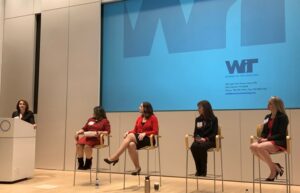Women in Technology

WiTConnect: State of Technology in Healthcare IT Panel
Women in Technology recently hosted their quarterly WiTConnect event focused on the state of technology in healthcare. This event focused on the top challenges faced in the Healthcare IT industry by bringing a panel of industry experts to share their experiences. Predominantly focused on the public sector, the following panelists shared the priorities, challenges and innovations being seen from both sides of the industry as they look for solutions and work together to improve citizen and agency experience:
- Stacie Alboum, Deputy Director, Center for Information Technology (CIT), National Institutes of Health (NIH)
- Maheen Mirza, Director, Dell Technologies, Federal Healthcare
- Genevieve Morris, Founder, Integral Health Strategies (IHS)
- Patty Obermaier, Vice President, US Health & Life Sciences Organization, Microsoft
Overall Challenges
The imbalance of supply (a trained healthcare workforce) and demand (greater need for services) is a top challenge facing the industry. According to Patty Obermaier from Microsoft, the population of those aged over 60 will more than double by 2050 and there will be a shortage of 14 million healthcare workers by 2030. While the right technology can help meet some of the demand, it can’t replace people. Multiple panelists agreed that a strong workforce development effort must take place within this field while healthcare IT technologies continue to catch up.
In addition, a data explosion has also happened in this field. According to Obermaier, “There are four thousand new medical publications showing up on PubMed every day and knowledge of the medical field doubles every 73 days.” Genevieve Morris, founder of IHS and author of multiple policies, also noted a significant increase in the amount of data being exchanged within the medical community. She likened it to, “turning on a faucet… a fire hydrant really… and expecting physicians to weed through that data in real time while their patient is sitting in front of them. Realistically that’s not going to happen, things will get missed and adverse events will occur.”
Finally, in a digital age, patients are also digital consumers with their own needs. Their health care expectations are likening to their expectations for all consumer interactions. When they walk into any health institution, they expect that institution to have all their records available and be able to pay for interactions the same way they pay across other markets, for example, with apps such as Venmo. For many reasons, these expectations cannot currently be met.
Key Public Sector Challenges
Healthcare IT in the public sector brings its own unique challenges. These include:
- Highly regulated federal environment
- Complex procurement and budgets
- Working and maintaining legacy IT systems
Stacie Alboum, Deputy Director at the Center for Information Technology at NIH, shared that, beyond those challenges, her agency faces a high level of complexity and range of services including a vast array of institutes and centers each focused on their own mission. Alboum’s agency is tasked with being efficient and effective in providing tools and services that provide a high-speed network to perform research; a suite of communication collaboration capabilities able to support hundreds of thousands of meetings and interactions; and high performance computing capabilities to conduct large scale data analyses in a variety of scientific fields to all 44K staff members and thousands of external collaborators.
Meeting the demands of all centers and institutes is only one piece of the complex needs of many public sector healthcare IT professionals. Like many other agencies, those in healthcare IT are spending a majority of their capital expenditure budgets (roughly 80%) on operating and maintaining legacy IT systems. To modernize IT, agencies are finding innovative ways to work with and learn from industry. Because certain vehicles are not in place, agencies are looking at using Other Transaction Authorities (OTAs) in order to help them get products, pilots and proof of concepts to market much faster. They have been open to private/public partnership to learn from industry and to are willing to talk to industry to hear what they are doing to see how they can also take advantage of it.
Looking Forward
AI and machine learning tools are also being developed by industry to help with the collection and exchange of data, the shortage of qualified workers and the streamlining of administrative processes. One example is a prototype being released by Microsoft that includes a tool that listens to and transcribes interactions between doctors and their patients, allowing practitioners to focus more on their patients and less on note-taking.
Additional tools may help practitioners weed through and pull the data they need when they need it. To help with data exchange and interoperability, Morris noted her work on the Trust Exchange Framework and Common Agreement (TEFCA). The goal of TEFCA is to make all health information networks across the country talk to and share data with each other. This will mitigate the need for healthcare systems to join multiple networks in order to share data.
Information blocking regulations underway may also help minimize the hoarding of data. Fast Healthcare Interoperability Resources (FHIR) APIs could help with the exchange of electronic health records. The goal is not to commoditize the data exchange, but to allow vendors to make money on the services you can run on top of that data.
A Word of Warning
Technology may help provide more efficient and effective solutions for many challenges being faced in the industry, but those in healthcare IT need to remember not to lose track of the problems they are trying to solve.
An exclusive focus on the “technology” part of healthcare IT causes many to fall into the trap of thinking the latest technology will solve all interoperability problems, leading them to over-complicate seemingly simple problems in order to provide new technological solutions. Many folks focus on, as one panelist put it, “the shiny new thing.” Whether that’s AI, machine learning, FHIR APIs, or other technology, you must make sure not to lack underpinning infrastructures necessary to the technology work.
And as companies look to promote technology solutions to their customers, they need to understand that those working in healthcare have been burned by technology companies in the past and may hesitate or be open to new concepts. This includes the fact that some problems do not require technological solutions at all. While we are in an era of convenience and technology, in some cases, an actual face-to-face or manual solution may prove best.
Want to Learn More?
Panelists provided a few resources for more information about healthcare IT.
 Interested in the media habits of federal healthcare professionals? Market Connections has created a new Federal Media & Marketing sub-report for this market. Purchase here.
Interested in the media habits of federal healthcare professionals? Market Connections has created a new Federal Media & Marketing sub-report for this market. Purchase here.
 Earlier this summer Market Connections attended Women in Technology’s (WIT) “Decoding B2B & B2G PR & Marketing Trends” in partnership with Merritt Group. This informative discussion brought together a panel of leading marketing and PR professionals from small to large companies including Bitdefender, Hybrent, KPMG US and Microsoft to discuss challenges they face and successes they’ve had in marketing to other businesses and the public sector.
Earlier this summer Market Connections attended Women in Technology’s (WIT) “Decoding B2B & B2G PR & Marketing Trends” in partnership with Merritt Group. This informative discussion brought together a panel of leading marketing and PR professionals from small to large companies including Bitdefender, Hybrent, KPMG US and Microsoft to discuss challenges they face and successes they’ve had in marketing to other businesses and the public sector.
In part two (read part one) of this blog post series we’ll focus on a second challenge discussed by panelists: broken internal systems and processes.
How Can We Better Work Together: Broken Internal Systems & Processes
Market Connections often works with B2G clients to support their business strategies from brand awareness through business development. The internal structure of these companies often varies, affecting the business growth efficiency and success of the organization. This was echoed by the panelists. Whether it’s interdepartmental communication, collaboration or even the simple inefficiencies in using marketing automation systems, the panelists shared their perspective on the good and bad of how their teams work together.
Sales & Marketing: A Contentious Relationship? Or Working Together?
How many times have we heard the following:
“The marketing leads don’t give us what we need” or “the sales rep just cares about his or her individual sales”
While each group may have different short-term goals, both need to work together to achieve long-term success.
According to Marni Puente, Market Development Leader from KPMG every member of her team must focus on the organizational client interaction plan, understand where the strategic relationships are, and together support negotiations, decision-making and networking. In her perspective, “If you’re responsible for marketing you’re responsible for business growth too.” She continues to say, “Whether it’s…doing business development [yourself], or …. working closely with the business development team, (business growth) is something every marketer thinks about.”
Are companies structured for this integration?
Market Connections conducted a study of government contractors in 2018 that revealed that over half (51 percent) of respondents stated their business development (BD/Sales) and marketing departments reported to different supervisors, nearly four in ten reporting to a single supervisor and the remaining listing either BD reporting to Marketing or vice-versa. While more than half may be reporting to different supervisors, this does not mean there isn’t room for integration; meeting regularly can ensure communication and alignment of business goals.
According to our study, many successful companies, nearly two-thirds of respondents, said their sales and marketing teams meet at least once a month, and a quarter of which said they meet weekly. However, interestingly, nearly one in five said they meet maybe once a year, if at all. Anna Wehberg, Senior Director of Marketing at Bitdefender validated our results. “If sales and marketing are not aligned, business doesn’t seem to flow right.” According to Wehberg, her sales VP and her speak, text, or Skype every day.
According to the speakers, those departments that work together see better success. A strong relationship between these two departments is key. As one panelist put it, “When relationships are strained things are going to be bad… When things are good, they’re really good.”
The overall feeling is that there is a general trend moving towards the integration of sales and marketing, with a strong focus on relationship building between the two groups.
Marketing Supporting Business Development
How are marketers supporting their BD counterparts? At Microsoft, Tonya Klause, Communications Manager US and Americas Services, talked about reducing redundancies while maximizing the “story” of Microsoft. Marketing plays a key role in training their sales team to use tools such as LinkedIn, Navigator and Elevate. Skills and techniques to effectively reach customers include content sharing on Navigator and LinkedIn, helping executives develop their profile, unique voice, and blogging skills.
Marketing can also help support the BD/Sales teams through webinar trainings and follow-up. Wehberg explained that in addition to hosting training sessions, she records those sessions and saves them online for later access. She takes notes and pulls highlights from webinars and shares them along with links to the original webinar to team members via email as a follow-up. She even texts the sales teams to ensure they have the information. She tries to find different ways to give sales reps information in different formats and repeats the message several times, understanding that people may respond and learn differently.
In general, we are moving towards integration. In order to have success in the market, it is essential for marketing and sales to collaborate, communicate and have integrated strategies. Regardless of how departments are currently structured, these teams must work together toward their common business growth goals. Best practices include: keeping lines of communication open between executives, regular weekly or monthly team meetings for strategy and planning and providing training opportunities to ensure a unified external brand as well as a sharing of best marketing and sales practices.
Thanks again to WIT and Merritt Group for putting together a great event with insightful conversation around challenges and trends and many thanks to each panelist for thoughtful input that will be supportive to B2B and B2G marketers.
Read part one of our blog series providing an overview of the event and insights into top challenge: keeping content relevant.
 Earlier this summer Market Connections attended Women in Technology’s (WIT) “Decoding B2B & B2G PR & Marketing Trends” in partnership with Merritt Group. This informative discussion brought together a panel of leading marketing and PR professionals from small to large companies including Bitdefender, Hybrent, KPMG US and Microsoft to discuss challenges they face and successes they’ve had in marketing to other businesses and the public sector.
Earlier this summer Market Connections attended Women in Technology’s (WIT) “Decoding B2B & B2G PR & Marketing Trends” in partnership with Merritt Group. This informative discussion brought together a panel of leading marketing and PR professionals from small to large companies including Bitdefender, Hybrent, KPMG US and Microsoft to discuss challenges they face and successes they’ve had in marketing to other businesses and the public sector.
According to the panelists, some of the biggest challenges include: keeping content relevant, internal broken systems (processes), speed of the industry and General Data Protection Regulation (GDPR) and email marketing.
With so many great panelist insights around key challenges they face, we decided to report on highlights and recommendations across two separate blog posts. In this first of these two, we’ll focus on the first of the challenges identified: keeping content relevant.
Content Generation
Understanding the importance of content marketing in reaching federal audiences, Market Connections seeks to understand best marketing practices so we can share and educate our clients serving the public sector. This includes conducting regular surveys and hearing from marketing experts. We were eager to hear from panelists at WIT Connect on best practices for keeping content relevant. From personalization, to purpose, to length and finally distribution, they provided some keen insights.
When it came to actual content creation, Anna Wehberg, Bitdefender’s Senior Director of Marketing, advised that content should be personalized, using the target audience’s language while avoiding the use of jargon and acronyms. (Read more about Market Connections’ similar findings of the most “annoying jargon” among federal decision-makers.) Marni Puente, Market Development Leader from KPMG agreed. Content should keep an end-user in mind. She went on to say, “Content should offer something of value, it’s not just about the sales, but think about what is in it for them.”
What does the public sector value in content? Looking at key features from our recent study in this market, content should always have the three following features: product specifications, examples of past performance and data and research to support content. Puente’s comments echoed these results, “I’m a big fan of content having primary research… Being able to offer data nuggets…is a great way to reel people in and go into meetings with a CIO and say ‘hey did you know, our survey shows this…”
In addition to personalization, Wehberg discussed the importance of having content for unique phases of the buying journey, including:
- Awareness and education
- Consideration (recognize I have a problem, now who are my players that can solve that problem)
- Preference (making a purchase and taking next steps)
For each of these phases, she noted that content should be trackable and have a purpose. If it wasn’t generating business on the other end, it should be reconsidered. Market Connections also found the importance of having unique content dependent on the stage of the buying process. Content across all three phases should be informative and educational. As you move further down the funnel, certain marketing assets like case studies and product demos become more and more important. (Learn more in our 2017 Federal Content Marketing Study.)
Puente also highlighted the shift over the past 5 years from the long narrative to more snackable/digestible content as a teaser to help reel them in. Tonya Klause, Communications Manager US and Americas Services at Microsoft agreed. “While there is a place for longer-form storytelling content… it has fallen out of favor.” Technology is playing a role in how long content is holding our attention, or as Klause put it, “We are all trained to focus on something for a couple seconds before moving on.”
Marketers should also consider their audience’s demographics. What captures the attention of the incoming, younger workforce, and for how long? According to our recent study, younger audiences are willing to spend more time with content they can sit back and listen to or watch such as webinars, videos and podcasts.
(Learn more about how long federal audiences are willing to spend with content.)
Klause continued to say that for Microsoft, it’s important to incorporate customer references in their storytelling; however, getting government references is one of their biggest challenges. According to our 2018 Federal Media & Marketing Study, over half of respondents listed recommendations from peers and colleagues as a most trusted source of information and over one-quarter cited customer testimonials. While it may be challenging to secure a government reference, there can be some workarounds. For example, anonymizing the referrer by using a case study (listing only the agency or agency type) could be one way of showcasing past experience. Citing a local or state agency (who may have less restrictions) or an industry reference could be another. According to our recent study, federal decision-makers looked to insights from industry thought-leaders even more so than their government counterparts.
Thanks to WIT and Merritt Group for putting together a great event with insightful conversation around challenges and trends and many thanks to each panelist for thoughtful input that will be supportive to B2B and B2G marketers.
Keep an eye out for a future blog post focused on the second key challenge identified: internal broken systems and processes, coming later this month.
Market Connections would like to congratulate all winners of the 20th annual Women in Technology’s (WIT) Leadership Awards. Presented on Thursday, May 9th, the awards showcase the outstanding accomplishments and contributions of female leaders in academic, entrepreneurial, government and corporate roles across the Washington, DC technology community.

Market Connections CEO, Lisa Dezzutti (4th from left) with WIT award winners. Courtesy of Women in Technology
The 2019 winners include:
- Corporate: Large-Market Sector – Toni Townes-Whitley, Microsoft
- Corporate: Mid-Market Sector – Padma Chitrapu, Neustar, Inc.
- Corporate: Small-Market Sector – Hildi Pineda, AbleVets LLC
- Rising Star – Allison Farris, Microsoft
- Small Business/Entrepreneur – Janel Merritt, DigiDoc Inc. dba Public Sector Solutions Groups
- STEM Leadership – Meg Layton, Symantec Corporation
- Unsung Hero – Mahwish Hamlani, Accenture
- Government – Chérie Smith, U.S. Army Program Executive Office Enterprise Information Systems (PEO EIS)
- Women in Defense – Darlene Straub, Defense Information Systems Agency
- Academia – Jill Klein, American University
Additional Awards
United Therapeutics Corporation was presented the Leadership Foundry’s Corporate Leadership Award for their efforts in making a difference in gender diversity on their board of directors and in their C-Suite.
The WIT Champion Award, honoring a current member of WIT who has shown exemplary dedication to the organization and mission, went to Leslie Bauer, WIT Treasurer, and a CPA & Cyber Risk Executive.
The WIT President’s Award was given to Marian McKee, Senior Director, Global Operational Services at BioReliance and 2015-2019 Chair of the STEM for Her Board of Directors recognizing her work in fostering a strong partnership between WIT and STEM for Her (WIT’s non-profit foundation focused on promoting education to create awareness, excitement and opportunities among girls and young women to pursue successful STEM-related careers).
According to Margo Dunn, WIT president, the Leadership Awards Gala served as a double celebration: 25 years of Women in Technology and 20 years of their Leadership Awards program. Over the past 20 years, WIT has honored more than 1,000 stellar female leaders in technology.
In response to this monumental anniversary, Market Connections CEO and former WIT Board Chairperson, Lisa Dezzutti, said, “The mission of advancing women in their technology careers from the classroom to the boardroom is as important today as it was 25 years ago. I am so proud to be a part of an organization that continues to grow and deliver on its mission.”
See the Women in Technology’s full press release.
